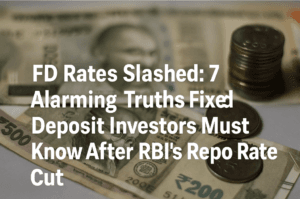FD Rates Slashed: 7 Alarming Truths Fixed Deposit Investors Must Know After RBI’s Repo Rate Cut
Following the RBI’s 25 basis point repo rate cut to 6%, major banks like SBI, HDFC Bank, and Bank of India swiftly trimmed fixed deposit (FD) rates, particularly impacting 1–3 year tenures. SBI reduced rates by 10 bps, while HDFC Bank slashed longer-term deposits by up to 40 bps, and Bank of India discontinued its high-yield 400-day FD scheme. Senior citizens, though still receiving preferential rates, face diminished returns as banks pivot toward liquidity-boosting measures.
The rate cuts reflect quicker monetary transmission, urging investors to rethink passive savings strategies. Experts suggest exploring alternatives like short-duration debt funds, corporate bonds, or post office schemes to counter shrinking risk-free returns. With inflation concerns lingering, balancing safety and growth through diversification may become critical for safeguarding purchasing power in a lower-rate environment.

FD Rates Slashed: 7 Alarming Truths Fixed Deposit Investors Must Know After RBI’s Repo Rate Cut
The Reserve Bank of India’s (RBI) recent decision to slash the repo rate by 25 basis points (bps) to 6%—a move aimed at stimulating economic growth by boosting liquidity—has sent waves across the banking sector. For millions of fixed deposit (FD) investors, the immediate consequence is clear: lower returns on their savings. Here’s a breakdown of how major banks are adjusting their FD rates and what this means for your financial strategy.
Key Banks Revise FD Rates: A Closer Look
State Bank of India (SBI):
- Reduced rates by 10 bps on 1–3 year tenures, effective April 15, 2025.
- 1–2 years: Down to 6.70% from 6.80%
- 2–3 years: Down to 6.90% from 7.00%
- Senior citizens retain a 50 bps premium under the “We-Care” scheme (e.g., 7.40% for 2–3 years).
Bank of India (BOI):
- Cut rates by 25–50 bps on short-term FDs (91 days to 2 years).
- Discontinued its 400-day “special” FD offering 7.30%, signaling a shift toward shorter-term liquidity management.
HDFC Bank & Yes Bank:
HDFC: Slashed longer-tenure FDs sharply (e.g., 35–40 bps cuts on 2-year 11-month and 4-year 7-month deposits).
Yes Bank: Trimmed 12–24 month rates by 25 bps.
Canara Bank & PNB:
Canara: Maintains a competitive 7.25% on its 444-day FD, with seniors earning up to 8.05%.
PNB: Offers 7.10% on 390-day deposits, reflecting a trend of banks prioritizing mid-term liquidity.
Why Are FD Rates Falling?
The repo rate cut allows banks to borrow from the RBI at lower costs, reducing their reliance on high-interest FDs to fund loans. This “monetary transmission” is amplified by the central bank’s accommodative stance, which prioritizes economic growth over curbing inflation. For savers, however, this translates to diminished returns, particularly on 1–3 year deposits, which are most sensitive to policy shifts.
Who’s Impacted Most?
- Retirees & Seniors: While banks like SBI and Canara still offer senior citizen premiums (up to 8.05%), the base rate cuts erode earnings for those dependent on interest income.
- Conservative Investors: With risk-free returns shrinking, individuals avoiding market-linked instruments face tougher choices.
Smart Alternatives to Consider
Debt Mutual Funds:
- Short-duration funds may offer better yields than FDs, with potential tax efficiency if held over three years.
Corporate Bonds & NCDs:
- Higher-rated issuances often provide better returns than bank FDs, albeit with marginally higher risk.
Post Office Schemes:
- Instruments like the Senior Citizen Savings Scheme (SCSS) or 5-year Post Office FD still offer 7.5–8.2% interest, backed by sovereign guarantees.
Ladder FDs:
- Spread investments across tenures (e.g., 6 months to 5 years) to mitigate reinvestment risks during rate fluctuations.
Expert Insight: Adapting to the New Normal
“FD investors must recalibrate expectations,” says financial advisor Priya Menon. “While safety remains paramount, diversifying into hybrid instruments or dividend-paying stocks can hedge against inflation, which may outpace FD returns if rate cuts continue.”
The Road Ahead
With inflation hovering at 5% and FD rates for seniors barely touching 7.5%, real returns (adjusted for inflation) are thinning. The RBI’s rate cut cycle may persist if growth falters, urging investors to act swiftly.
Final Takeaway
Review your portfolio mix. If FDs are your anchor, lock in longer tenures from banks like Canara offering promotional rates. For higher risk tolerance, blend FDs with debt funds or bonds. In a low-rate era, flexibility and diversification are key to safeguarding your savings.
You must be logged in to post a comment.